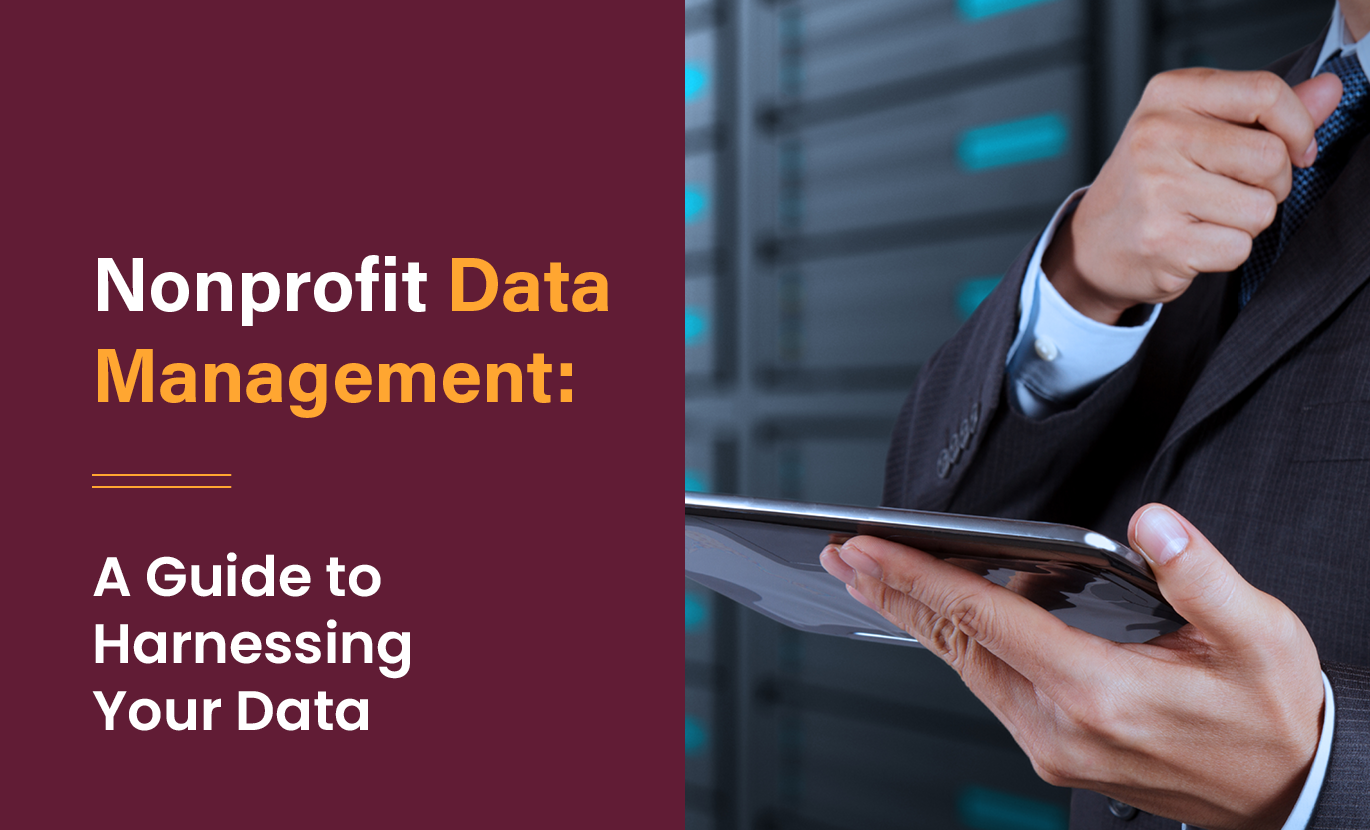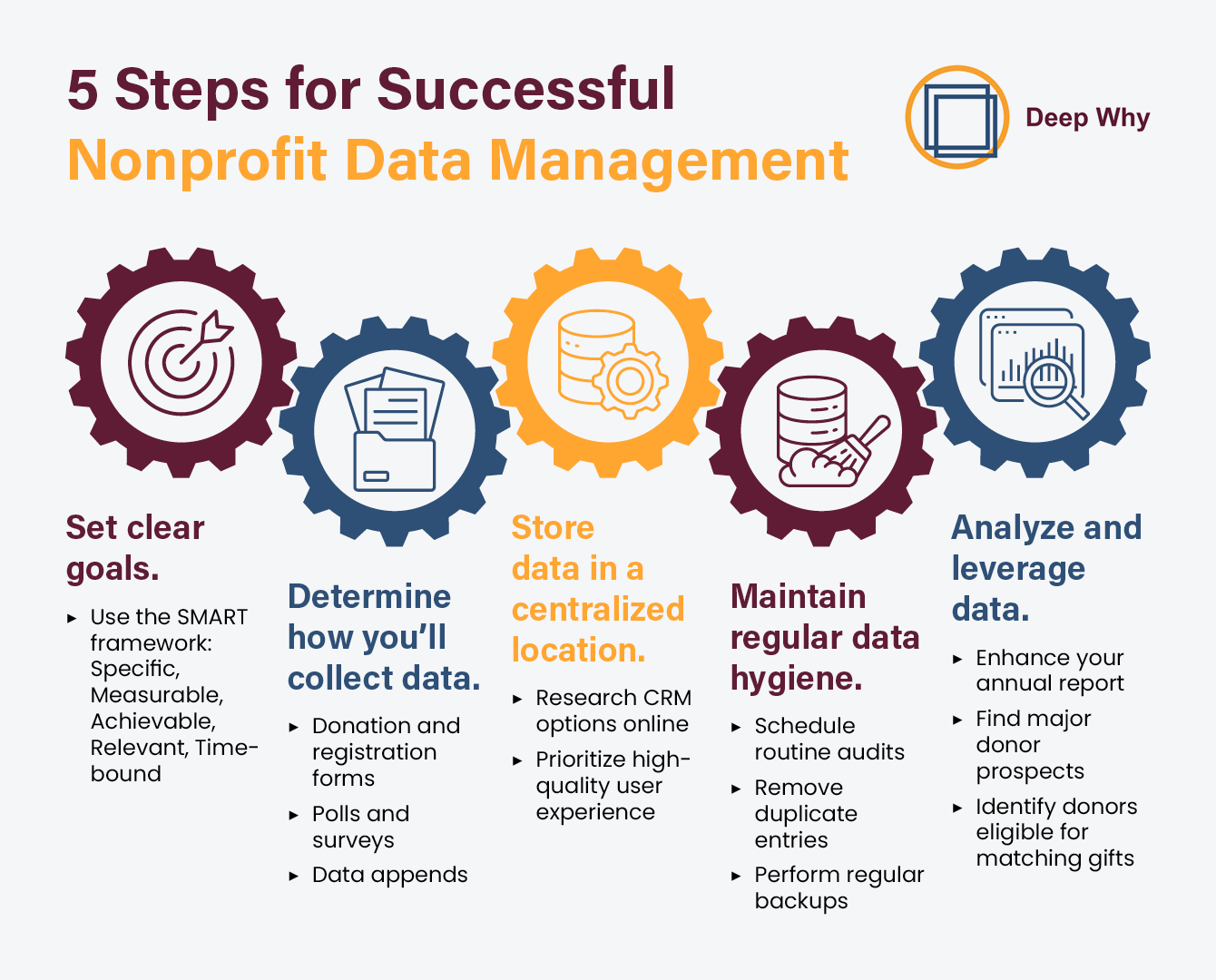Nonprofit Data Management: A Guide to Harnessing Your Data
Your nonprofit relies on the concerted efforts of its staff, board members, donors, and volunteers to carry out its mission. From fundraising to program delivery, there’s a lot to keep track of every day.
With so much to manage, how do you know that you’re allocating your budget to the right areas? How do you ensure you’re directing your outreach toward the right people?
By establishing a dedicated process for nonprofit data collection and management, your nonprofit can equip itself with valuable insights to improve decision-making, streamline operations, and make the most of its resources.
This guide will cover everything you need to know about nonprofit data management, including:
Nonprofit Data Management: The Basics
5 Steps for Successful Nonprofit Data Management
Best Practices for Nonprofit Database Management
Your nonprofit’s data can be a powerful tool to inform your goals, strategies, and daily activities. This is especially important for frontline workers who need accurate and up-to-date information to provide effective services to your program participants. Let’s get started!
Nonprofit Data Management: The Basics
Put simply, nonprofit data management refers to the process of collecting, organizing, and using data to enhance your nonprofit’s operations and boost your results. However, due to the sheer amount of information you’re working with daily, successful database management requires thoughtful procedures and planning.
Let’s start by exploring a few frequently asked questions:
What is a nonprofit database?
Whether you’re a nonprofit dedicated to overcoming food insecurity or a museum that curates a collection of contemporary art pieces, using a nonprofit database allows you to store all the details related to your supporters, programs, and more in a single location. With this software, you can track relationships, automate communications, and generate detailed reports to measure your results.
Salesforce is a popular option for many nonprofits since it comes with advanced features that facilitate internal collaboration and is always evolving to use the latest innovations for data-driven insights.
Why is nonprofit database management important?
It’s no secret that the nonprofit world is full of ever-changing trends and community needs. Proper nonprofit data management helps you stay on your toes and ahead of the curve by:
Guiding your goal-setting and strategic planning
Informing how you allocate your resources
Enabling you to tailor your supporter communications
Providing insights for improving your programs
Measuring your impact
Having clean, accurate data sets your nonprofit up for future growth and improvements, ensuring your long-term success and sustainability.
What types of data should nonprofits collect?
Data is a broad term that can be broken down into two types:
Quantitative data: Data you can measure in numbers, such as your donor retention rate or average gift amount.
Qualitative data: Data that describes what you can’t capture numerically, such as a volunteer’s reasons for supporting your organization or a beneficiary’s recounting of how your nonprofit impacted their life.
The types of data you choose to collect and prioritize will depend on your nonprofit’s overall goals. For instance, some popular data points include donor demographics, event attendance, and marketing engagement.
5 Steps for Successful Nonprofit Data Management
Nonprofit data management is not a one-person job. Therefore, it’s important to assemble a team and ensure that everyone stays on the same page going forward. Follow these steps to get started:
1. Set clear goals for your data.
Your nonprofit’s data needs will differ based on your mission, programs, and objectives. Rather than tracking every data point under the sun, define your goals upfront so that you’re only focusing on the key performance indicators (KPIs) that will directly contribute to your goals.
Use the SMART framework to support your efforts:
Specific: Be precise and use numbers to detail exactly what you’re trying to accomplish.
Measurable: Outline a goal that you can track your progress toward using specific criteria.
Achievable: Your goal should be challenging yet reasonable based on your resources and priorities.
Relevant: Tie your goal back to your overall mission to ensure that it will make a meaningful impact on the lives of those you serve.
Time-bound: Set a deadline that your team will work toward.
For example, an education nonprofit might set a goal like this: “Increase the employment rate of participants who complete our career readiness mentorship program by 25% before the end of the year.” To do so, they may pay special attention to attendance rates and participant feedback, making improvements in their strategy along the way as necessary.
2. Determine how you’ll collect your data.
Once you have a better idea of the types of data your nonprofit wants to collect and why, it’s time to determine how you’ll access this information. For example, let’s say you’re hoping to collect demographic data points from your community. One of the most straightforward and respectful ways is to ask, whether that’s on your donation page, in your membership sign-up form, or through your event registration. Add a reasonable number of fields that ask for details such as age or employer information.
Furthermore, you can send out a variety of polls or surveys to gather more in-depth data. For example, if you’re looking to boost participant satisfaction in one of your programs, consider sending out a survey to learn more about their experiences and areas to improve. You might determine that many of them would appreciate a more streamlined intake process, leading you to invest in a software solution that expedites some of the steps.
If you notice any persistent gaps in your database, consider investing in a data append. A data append service pulls from external sources to provide you with comprehensive, accurate information such as email addresses and donor employment. Other tools, like Google Analytics, event platforms, and volunteer management software can help you get your hands on more specific data points like your event attendance or volunteer retention rate.
3. Store your data in a centralized location.
A nonprofit database, or CRM, makes it easy for your staff and volunteers to store all your data and reference it later. This means that everyone will have access to the information they need to carry out their daily tasks, whether they’re a frontline worker or a volunteer coordinator.
If you’re on the hunt for a new solution, follow these tips to find the right fit for your nonprofit:
Set a realistic budget.
Research options online and read reviews.
Consider integration capabilities.
Request demos and take advantage of free trials.
Prioritize software that offers a high-quality user experience to set your staff and volunteers up for success in the long term. If you need additional support in finding and customizing your solution to fit your specific needs, there are plenty of experts who will walk you through the process of tailoring your technology toolkit to maximize results.
4. Maintain regular data hygiene.
After putting in the effort to collect and store data for your nonprofit, keep everything in tip-top shape by following data hygiene best practices such as:
Scheduling routine audits to correct errors and identify information gaps.
Removing duplicate entries in your database.
Performing regular data backups to safeguard your records.
A well-maintained database ensures that all users at your nonprofit can leverage your data with accuracy and confidence, whether they’re sending out fundraising communications or following up with program participants.
5. Analyze and leverage your data.
With clean, accessible, and accurate data, your nonprofit can start putting it to good use in your daily operations. While you should outline how you plan to use your data in advance, there are plenty of impactful and creative ways to make the most of your database, including:
Reaching out to supporters before their birthdays and encouraging them to start a birthday fundraiser on your behalf.
Enhancing your annual report with charts and infographics related to your impact.
Finding major donor prospects based on their wealth data and philanthropic involvement.
Identifying donors who are eligible for corporate matching gifts and prompting them to submit a request.
By using your nonprofit’s data to inform your interactions with donors, volunteers, program participants, and other members of your community, you’ll be able to build stronger and more meaningful relationships to fuel your mission year after year.
Best Practices for Nonprofit Database Management
Your nonprofit’s database can be a treasure trove of insights as long as you set it up and maintain it properly. Explore these best practices to become an expert in nonprofit data management:
Standardize data entry. Since you’ll probably have multiple staff members and volunteers interacting with your nonprofit’s database, create a document that contains all of your data entry procedures, including naming conventions and formatting standards. For example, you might require users to input full, unabbreviated names for each record, and then include any preferred nicknames in a separate field.
Ensure data security. 27% of nonprofits surveyed by Nonprofit Tech for Good have experienced a cyberattack. Protect your database by implementing a strong password policy that includes multi-factor authentication, keeping your software updated, using anti-virus software, and setting user controls that limit who has access to and can make changes to your data.
Provide training to staff and volunteers. Offer regular training opportunities on how to use and make the most of your nonprofit’s database. You can cover anything from troubleshooting common issues to cybersecurity topics such as phishing. Preparing your staff and volunteers is especially important if they rely on your nonprofit’s data to perform their daily work, such as assisting program participants at a health services nonprofit.
Finally, don’t hesitate to reach out to nonprofit technology firms that have the tools and expertise to help you improve your data management strategy. At Deep Why Design, we’re committed to supporting nonprofit organizations in creating the best possible Salesforce user experience for your staff and volunteers.
Whether you’re a small to mid-sized nonprofit looking for some expert advice or you have a more precise goal you’d like to tackle, we offer Office Hours and Advanced Office Hours to hone your data management according to your specific needs and goals.
The Impact of Effective Nonprofit Data Management
Your nonprofit’s staff members put significant effort into their daily roles and responsibilities. With a well-maintained database and strong data management practices, you can equip them with the insights they need to carry out their tasks more successfully.
In the long term, your team will be well-versed in storing key details about supporters and program participants, using data insights to guide decision-making, and reporting your impact on your community.
Our database specialists at Deep Why are here to support you along your journey to better nonprofit data management. Feel free to reach out and learn how we can help you meet your goals and leverage your database to the fullest.
For more information on nonprofit technology and data management, explore these additional resources:
Why is our enterprise software so terrible? Your nonprofit’s technology should streamline, not hinder, your daily operations. Dig deeper into common challenges of enterprise systems and their origins in this article.
Nonprofit database implementation: what most firms still get wrong (and how to fix it). A nonprofit technology firm should set your team up for long-term success with your software rather than provide short-term solutions. Explore what this looks like in this guide.
The Nonprofit Operations Guide: Operating Model. An operating model ensures that everyone in your organization understands how to fulfill their roles and progress toward your goals. Learn more in this guide.


